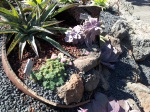
The Fox Theater is now home to Rudy’s Can’t Fail Cafe and the Oakland School for the Arts.
This two-mile figure-eight loop takes you past some of the most distinguished commercial architecture in Oakland, as well as some of the hippest dining and nightclubbing neighborhoods. Times being what they are, you are also likely to see a few abandoned storefronts and street people.
If you want the route to yourself, walk early on a weekend morning. If you want to see the area at its liveliest, visit on a First Fridays Art Walk evening, when galleries between Broadway and Telegraph Avenue are open late, the bars are full of music, and the streets are full of people strolling from venue to venue. A daytime route will give you a chance to appreciate the finer architectural details, but the neon comes to life at night.
Starting at West Grand Avenue, walk down Broadway past the pale green Breuner Building, which has a classic Deco facade and a relief of two workers building a chair over the door. Since the furniture company abandoned it in the 1970s, it’s been used as office space for smaller concerns, including the California Genealogical Society.
A block away is the 3000-seat Paramount Theater, a lovingly restored picture palace built in 1931. Originally rescued by the Oakland Symphony in the 1970s, it now shows classic movies and hosts concerts and other special events. Although the outside is impressive — especially lit up at night — it is the inside that is truly astonishing. Almost next door is the I. Magnin building, a jewel box of brilliant green terra cotta and black marble.

Art Deco clock and the Oaksterdam mural, recently painted over.
Keep heading downtown and you pass through Oaksterdam, a neighborhood of medical marijuana dispensaries. Even on a Sunday morning, you might notice a slightly skunky smell. The Art Deco street clock at 16th and Broadway was recently restored, and makes a humorous counterpoint to the brilliantly-colored modernist mural across the street. (Update: The “Oaksterdam” mural was painted over in December 2012.)
Look up frequently, as most of the finest architectural details are above eye level: glazed terra-cotta tiling, brickwork and elegant reliefs. Some shops have homely window displays and fading awnings beneath brilliant cornices and moldings.
After passing the remarkable Cathedral Building, a Gothic Revival sliver at the narrow vee of Telegraph and Broadway, you can catch a glimpse of Oakland’s Beaux-Arts City Hall through a gap between the Rotunda Building and the Lionel Wilson government office building. All three were built after the 1906 earthquake and had to be heavily renovated after Loma Prieta in 1989.
Continuing down Broadway past DeLauer’s Super News Stand, turn right on 11th Street into Old Oakland. These Victorians were part of the original downtown, when Seventh Street was the terminus of the Central Pacific. The ones on this block have an unusual courtyard below sidewalk level, protected by black iron fences and bridged by walkways to their front doors. The effect is very New York-ish.
Going right on Clay Street, you pass the back side of Swan’s Market, built as a regional shopping destination between World Wars I and II. It now houses several very good restaurants and the Museum of Children’s Art. Clay also takes you past some of Oakland’s newer architectural landmarks, including the Ronald V. Dellums Federal Building. When it was finished in 1994, the public could visit the sky bridge between the twin 18-story towers. Security concerns now limit casual visitors to the rotunda.

Oakland City Hall
Turn right again on 14th street, and walk through Frank Ogawa Plaza in front of City Hall. The enormous oak tree and lawn are recovering nicely from the effects of the Occupy Oakland protests. Continuing left up Telegraph, you re-enter Uptown and pass the Fox Theater with its lovely, intricate brick facade showing a Moorish influence. Like the Paramount, it is a venue for concerts and special events. It also houses the Oakland School for the Arts, a public magnet school. Across from the Fox is the Flower Mart building, dramatically tiled in midnight blue terra cotta with silver accents. The Uptown Nightclub has matched the facade with a vintage-looking neon sign in the shape of a guitar neck.
The next stretch of Telegraph includes a variety of new, refurbished, and built-new-to-look-old apartment buildings. Jerry Brown’s goal during his mayoralty in the early 2000s was to create living spaces for 10,000 new residents downtown. While there is still debate over how much credit Brown can claim, these new urban living spaces have had an indisputable effect in reviving the area.
It’s worth mentioning — and noticing — the 1911 brick YMCA Building, also known as the Hamilton Hotel, which was renovated into studio apartments in the 1990s. And finally, at 22nd and Telegraph, the Romanesque First Baptist Church building. Damaged in the 1906 earthquake, it was renovated by Julia Morgan and is now in use by a Burmese congregation.
Getting there: Street parking is available but may be scarce during Art Murmur or other big events; two BART stations and a number of bus stops are on this route.
Cool stuff in the neighborhood: Besides everything mentioned above, there are dozens of galleries between Telegraph and Broadway (listed at the Art Murmur site). Chinatown (which starts at 8th and Broadway) and Auto Row (Broadway above 27th) also have some interesting architecture and restaurants.
More information: About guided tours through Oakland Heritage Alliance here. About self-guided tours using a Chamber of Commerce map here.






















